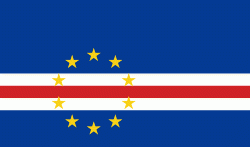São Filipe (São Filipe)
São Filipe (Portuguese for "Saint Philip") is a city on the west coast of the island of Fogo, Cape Verde. It is the capital of the island, and the seat of the São Filipe Municipality. The island's airport, São Filipe Airport, is located on the southeastern edge of the town and the island's port is 4 km north of the center at Vale de Cavaleiros. The town's elevation is 20 meters.
São Filipe was founded in the 16th century and is considered to be the second oldest town in Cape Verde after Ribeira Grande, but a town charter was not granted before 1922. It prospered due to the cultivation of cotton, which was sold on the African coast. In 1655 São Filipe was destroyed by Flemish pirates. In the 18th century it went into economic stagnation, as did Ribeira Grande. The cultivation of cotton was replaced by wine, coffee and jatropha (for oil and soap production), which led to an economical upswing in the 19th century. Representative town houses (sobrados) were built in the city centre, around the parish church. Currently, 70% of the houses in the city centre date from the 19th century.
São Filipe was founded in the 16th century and is considered to be the second oldest town in Cape Verde after Ribeira Grande, but a town charter was not granted before 1922. It prospered due to the cultivation of cotton, which was sold on the African coast. In 1655 São Filipe was destroyed by Flemish pirates. In the 18th century it went into economic stagnation, as did Ribeira Grande. The cultivation of cotton was replaced by wine, coffee and jatropha (for oil and soap production), which led to an economical upswing in the 19th century. Representative town houses (sobrados) were built in the city centre, around the parish church. Currently, 70% of the houses in the city centre date from the 19th century.
Map - São Filipe (São Filipe)
Map
Country - Cape_Verde
 |
 |
The Cape Verde archipelago was uninhabited until the 15th century, when Portuguese explorers discovered and colonized the islands, thus establishing the first European settlement in the tropics. Because the Cape Verde islands were located in a convenient location to play a role in the Atlantic slave trade, Cape Verde became economically prosperous during the 16th and 17th centuries, attracting merchants, privateers, and pirates. It declined economically in the 19th century after the suppression of the Atlantic slave trade, and many of its inhabitants emigrated during that period. However, Cape Verde gradually recovered economically by becoming an important commercial center and useful stopover point along major shipping routes. In 1951, Cape Verde was incorporated as an overseas department of Portugal, but its inhabitants continued to campaign for independence, which they achieved in 1975.
Currency / Language
| ISO | Currency | Symbol | Significant figures |
|---|---|---|---|
| CVE | Cape Verde escudo | Esc or $ | 2 |
| ISO | Language |
|---|---|
| PT | Portuguese language |















